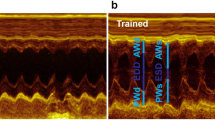Summary
Adaptation of rats to repcated short-term stress exposure prevents, to a considerable extent, contractural and arrhythmogenic effects of high concentrations of extracellular Ca2+ on isolated heart. Increased efficiency of SR Ca2+-pump functioning and a significant increase in Ca2+ pump resistance to autolysis are proved to play the main role in this effect.
Similar content being viewed by others
References
Ashenbrenner D, Rabinovitz M (1971) Cardiac hypertrophy. Academic Press, NY
Belham HRB (1984) HSP 70 accelerates the recovery of nuclear morphology after heat shock. Eur Mol Biol Org J 3:3095–3100
Bergey JL, Werdt RL, Nocella K, McCallum JD (1984) Acute coronary artery occlusion-reperfusion-arrhythmias in pig: antiarrhythmic and antifibrillatory evaluation of verapamil, nifedipine, prenylamine and propranolol. Eur J Pharmacol 97:95–103
Combettes L, Berthon B, Claret M (1987) Phospholipid second messengers and calcium. Biochimia 69:281–286
Currie RW, Whate FP (1981) Trauma-induced protein in rat tissues: a physiological role for a “heat shock protein”?, Science 214:72–73
Delcayer C, Samuel IJ, Marotte F et al (1988) Synthesis of stress proteins in rat cardiac myocytes 2–4 days after imposition of hemodynamic overload. J Clin Invest 82:460–468
Ende DJ, Martin AF, Jakovcic F, Zak R (1987) Induction of HSP 70 stress protein mRNAs during cardiac hypertrophy. J Am Coll Cardiol 9:38A (Abstr)
Gorclick FS (1987) Second messenger systems and adaptation. Gut 28:79–84
Escande D (1982) SR contributes to spontaneous automaticity in partially depolarized human atrial fibers. J Physiol 366:82
Hammond GL, Lai YK (1982) Diverse forms of stress lead to new pattern of gene expression through a common and essential metabolic pathway. PNAS 79:3485–3488
Jost HJ, Lindquist S (1986) RNA splicing is interrupted by heat shock and is reset by heat shock protein synthesis. Cell 45:185–193
Kahn MD (1964) Effects of ryanodine in normal dogs and in those with digitalis induced arrhythmias. Am J Cardiol 14:658–668
Malyshev IYu (1989) Adaptation of the organism to stress exposure increases the heart resistance to adrenotoxic damage. Bull Exper Biol Med, in press (Russ.)
Meerson FZ (1984) Pathogenesis and prevention of stress-induced and ischemic damages of the heart. Moscow, Meditzina (Russ.)
Meerson FZ, Belkina LM, Dusenov SS et al (1985) Prevention of disturbances of the heart electric stability in acute ischemia by preliminary adaptation to short-term stress action and antioxidant ionol. Kardiologiya 25:N 10, 29–33 (Russ.)
Meerson FZ, Belkina LM, Dusenov SS (1986) Prevention of disturbances of the heart electric stability in experimental myocardial infarction by preliminary adaptation to short-term nondamaging stress exposure and antioxidant ionol. Kardiologiya 26:N 8, 19–24 (Russ.)
Meerson FZ, Belkina LM, Dusenov SS (1986) Elimination of disturbances of the heart electric stability in postinfarction cardiosclerosis by adaptation to short-term stress exposure and antioxidant ionol. Bull Exper Biol Med 102:N 11, 536–538 (Russ.)
Meerson FZ (1987) Stress-limiting systems of the organism and the problem of protection against arrhythmias. Kardiologiya 27:5–12 (Russ.)
Meerson FZ, Malyshev IYu, Belkina LM, Saltykova VA (1988) Increased resistance of the heart to arrhythmogenic factors of adaptation of the organism to stress exposure. Kardiologiya 28:N 1, 70–74 (Russ.)
Meerson FZ, Pshennikova MG (1988) Adaptation to stressful situation and physical loads. Moscow, Meditzina (Russ.)
Meerson FZ, Yavitch MP, Lerman MI (1978) Decrease in the rate of RNA and protein synthesis and degradation in the myocardium under long-term compensatory hyperfunction and aging. J Mol Cell Cardiol 10:145–160
Opie L (1987) Myocardial ischemia-metabolism and its modification. SAMT 72:740–747
Pierce GN, Richt TL, Langer GA (1987) Trans-sarcolemmal Ca2+ movements associated with contraction of the rabbit right ventricular wall. Circ Res 61:805–814
Watanabe AM, Besch HR (1974) Cyclic adenosine monophosphate modulation of slow calcium influx channels in guinea-pigs hearts. Circ Res 35:317–324
Author information
Authors and Affiliations
Rights and permissions
About this article
Cite this article
Meerson, F.Z., Malyshev, I.Y. & Sazontova, T.G. Adaptation to stress exposure prevents arrhythmogenic and contractural effects of the excess of Ca2+ on the heart by the increased activity of sarcoplasmic reticulum. Basic Res Cardiol 85, 96–103 (1990). https://doi.org/10.1007/BF01907018
Received:
Issue Date:
DOI: https://doi.org/10.1007/BF01907018



